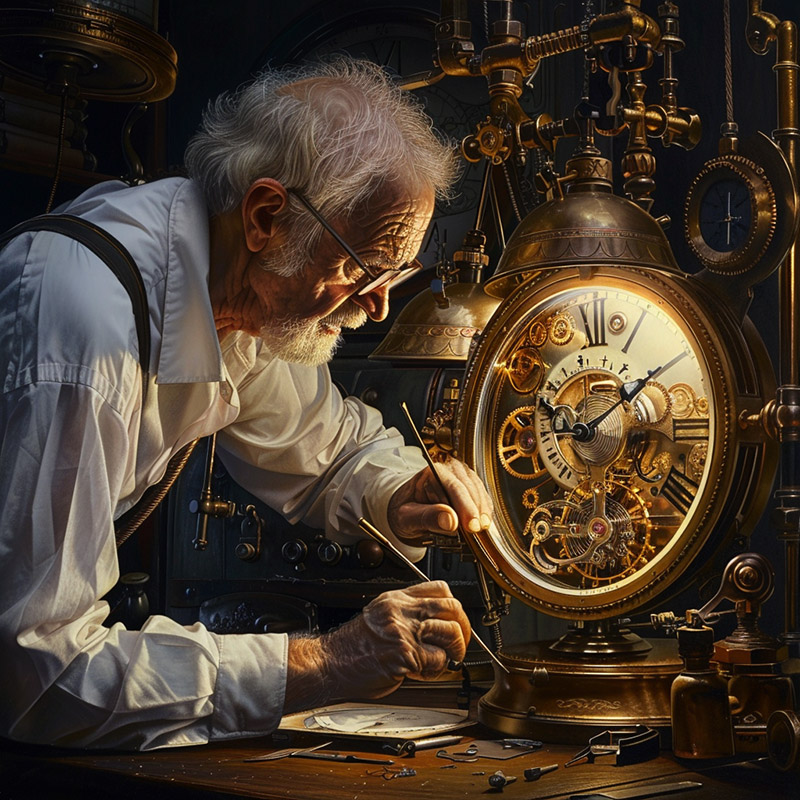
Tourbillons in General
Here are some key facts about tourbillons:
- Purpose - It aims to counter the effects of gravity on a watch's position that can cause inaccuracies. The tourbillon rotates the watch's escapement and balance wheel in a revolving carriage.
- Invention - Invented in 1795 by French-Swiss watchmaker Abraham-Louis Breguet. Considered one of the most significant innovations in horology.
- Operation - The rotating cage makes one revolution per minute, averaging out the effects of gravity on the watch in different positions. This improves precision.
- Position - Often located near the 6 o'clock position on the watch dial and visible through a small window. The rotating tourbillon is visually distinctive.
- Components - Consists of about 100 intricate parts including the cage, balance wheel, escapement, gear train and regulating mechanisms.
- Craftsmanship - Considered extremely challenging to produce and assemble due to the delicate construction, precision engineering and miniaturization required.
- Luxury Status - Found mostly in high-end luxury and prestige watch brands. Tourbillons are complex and costly to manufacture.
- Collectibility - Tourbillon watches are valued by collectors for their horological significance, craftsmanship and precision. They retain resale value.
The tourbillon is an advanced mechanism that rotates a watch's vital parts to achieve greater accuracy by reducing the effects of gravity. It represents watchmaking mastery and innovation.
2005 - Triple Rotary Tourbillon: Additional axes eliminate inaccuracies due to the watch movement's relative position to the earth and gravity

In 2005, Progress Watch Corporation developed a watch movement that complements the Triple Tourbillon Movement announced in August. The company has coined the name STAR for the new see-through triple axes rotary tourbillon movement.
The company continues to develop innovative precision watch technology. STAR features a movement with a single, three axes rotary tourbillon, indicating time directly from the tourbillon's position, without the need for additional hands.
The tourbillon mechanism completes a full rotation around the outer frame every 12 or 24 hours, depending on design. The inner dial indicates minute and makes a full rotation every 60 minutes while moving with the entire mechanism along the outer circle. Seconds can be indicated directly on the movement's centerpiece.
The double pointer simultaneously indicates the hour on the outer dial and the minutes on the inner dial, without the need for hands. Removing the need for hands allows the entire mechanism to be viewable from both sides, creating the first see-through tourbillon watch.
This new technology creates an all-new market segment for tourbillon-based watches by allowing manufacturers to design additional attractive and exclusive designs based on the see-through rotary triple axis movement. This includes the potential for a design that features a watch that can be read from either side. The design and technology allows for creative individualization of tourbillon-based watches.
The company's internal engineering and design team will follow with additional, innovative and highly flexible watch movement concepts.
Progress Watch's two new tourbillon movements are high end, accurate, precise devices that compensate for the inaccuracies in other types of mechanical watch movements due to the influence of the earth's gravitational pull on the movement. Tourbillon movements are the ultimate in mechanical watch movements. Most tourbillon-based watches have one-axis tourbillon mechanisms. In single axis tourbillons, the balance swings around one axis, to compensate for the earth's gravitational pull on the mechanism, resulting in highly improved accuracy over traditional mechanical watch movements. Unfortunately, these very expensive single axis tourbillon movements are very sensitive, quite unstable and easily damaged.
In this new three-axis tourbillon movements, the balance swings around two additional axes, eliminating virtually all inaccuracies due to the movement's relative position to the earth and the effects of gravity. Progress Watch's movements represent the ultimate in mechanical watch movements delivering unparalleled accuracy. The problems of instability and sensitivity are dramatically reduced in these new designs, making the STAR tourbillon movements less prone to damage.